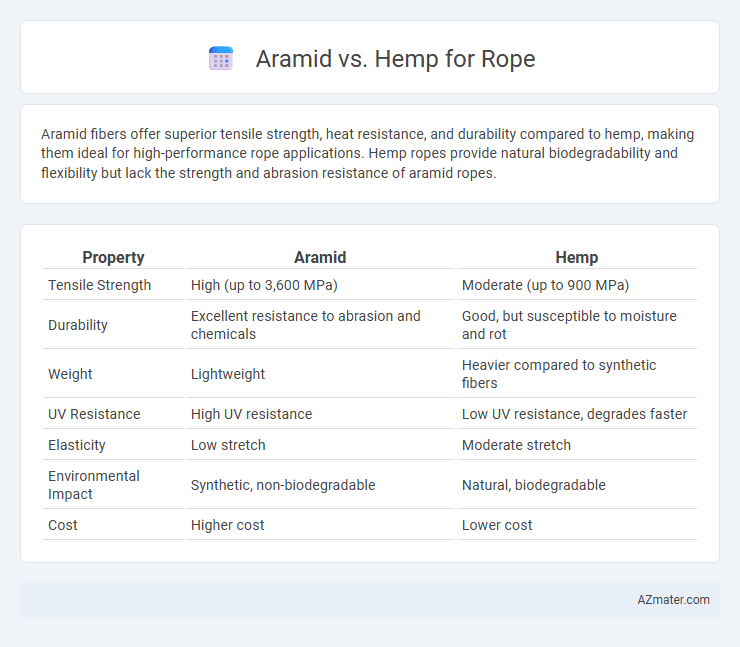Aramid fibers offer superior tensile strength, heat resistance, and durability compared to hemp, making them ideal for high-performance rope applications. Hemp ropes provide natural biodegradability and flexibility but lack the strength and abrasion resistance of aramid ropes.
Table of Comparison
| Property | Aramid | Hemp |
|---|---|---|
| Tensile Strength | High (up to 3,600 MPa) | Moderate (up to 900 MPa) |
| Durability | Excellent resistance to abrasion and chemicals | Good, but susceptible to moisture and rot |
| Weight | Lightweight | Heavier compared to synthetic fibers |
| UV Resistance | High UV resistance | Low UV resistance, degrades faster |
| Elasticity | Low stretch | Moderate stretch |
| Environmental Impact | Synthetic, non-biodegradable | Natural, biodegradable |
| Cost | Higher cost | Lower cost |
Introduction to Aramid and Hemp Ropes
Aramid ropes, derived from synthetic fibers like Kevlar, offer exceptional strength, heat resistance, and low stretch, making them ideal for demanding applications such as climbing, marine, and industrial use. Hemp ropes, made from natural fibers, provide excellent abrasion resistance, biodegradability, and a strong grip, commonly used in gardening, decoration, and traditional crafts. Understanding the distinct properties of aramid and hemp ropes helps in selecting the right material based on durability, environmental impact, and performance requirements.
Chemical Composition and Structure
Aramid fibers, such as Kevlar, consist of long chains of polyamides with highly ordered, rigid molecular structures composed of aromatic rings, which provide exceptional tensile strength and heat resistance. Hemp fibers are primarily composed of cellulose, hemicellulose, and lignin, featuring a complex, amorphous structure that offers moderate strength and natural biodegradability. The chemical rigidity and synthetic origin of aramid fibers result in superior durability and resistance to chemicals compared to the plant-based, biodegradable hemp fibers used for ropes.
Strength and Durability Comparison
Aramid fibers, such as Kevlar, exhibit superior tensile strength and resistance to abrasion compared to hemp, making them ideal for high-performance rope applications. Hemp rope offers natural resistance to UV light and moisture but lacks the long-term durability and strength retention under heavy loads that aramid provides. When comparing strength-to-weight ratios, aramid ropes outperform hemp by maintaining structural integrity under extreme stress and harsh environmental conditions.
Weight and Flexibility Differences
Aramid ropes, such as those made from Kevlar, offer superior strength-to-weight ratios, making them significantly lighter than hemp ropes of comparable tensile strength. Hemp ropes, while heavier, provide greater natural flexibility and stretch, which can be advantageous for shock absorption and ease of handling. The weight efficiency of aramid fibers suits high-performance applications, whereas hemp's pliability benefits traditional uses requiring softer, more elastic rope.
Resistance to Environmental Factors
Aramid ropes exhibit superior resistance to UV radiation, chemicals, and extreme temperatures, making them ideal for harsh environments and prolonged outdoor use. Hemp ropes offer natural biodegradability and moderate resistance to moisture but deteriorate faster under prolonged exposure to sunlight and fungi. When choosing between aramid and hemp, consider the specific environmental conditions and longevity requirements of the application.
Sustainability and Eco-Friendliness
Aramid fibers, derived from synthetic polymers, offer exceptional strength and durability but pose environmental concerns due to their non-biodegradable nature and energy-intensive production. Hemp rope, made from natural plant fibers, boasts superior sustainability by being biodegradable, renewable, and requiring minimal pesticides and water for cultivation. Choosing hemp supports eco-friendly practices, reducing plastic waste and promoting a circular economy in rope manufacturing.
Cost and Availability Analysis
Aramid rope, known for its high strength-to-weight ratio and heat resistance, tends to be significantly more expensive than hemp rope due to its synthetic manufacturing process and advanced material properties. Hemp rope, derived from natural fibers, remains widely available and cost-effective, making it a preferred choice for budget-conscious applications where extreme durability is not critical. Market availability favors hemp in regions with established agricultural production, whereas aramid rope requires specialized distributors, resulting in higher overall procurement costs.
Practical Applications in Industry
Aramid ropes, known for their exceptional strength-to-weight ratio and resistance to heat and abrasion, are widely used in aerospace, military, and marine industries where high-performance durability is critical. Hemp ropes, valued for their natural biodegradability and resistance to UV light, find practical applications in agriculture, landscaping, and eco-friendly packaging. While aramid excels in technical and safety-critical environments, hemp is preferred for sustainable and cost-effective solutions in less demanding industrial settings.
Maintenance and Lifespan
Aramid ropes exhibit superior resistance to abrasion, chemicals, and UV exposure, resulting in lower maintenance requirements and a longer lifespan compared to hemp ropes. Hemp ropes, while biodegradable and eco-friendly, demand regular inspections for fraying, mildew, and weakening from moisture, which can significantly shorten their usable life. The durability of aramid fibers like Kevlar ensures consistent performance in harsh environments, making them ideal for applications requiring minimal upkeep and extended service duration.
Choosing the Right Rope Material
Choosing the right rope material depends on the application's needs for strength, durability, and environmental impact, where aramid ropes provide exceptional tensile strength and heat resistance ideal for high-performance industrial uses, while hemp ropes offer natural biodegradability and excellent abrasion resistance suited for eco-friendly and traditional settings. Aramid fibers like Kevlar deliver superior strength-to-weight ratios and resistance to chemical degradation, making them preferable in demanding environments requiring long-lasting performance. Hemp ropes, derived from natural fibers, remain cost-effective and sustainable, excelling in applications where flexibility, grip, and environmental considerations take priority.

Infographic: Aramid vs Hemp for Rope
 azmater.com
azmater.com